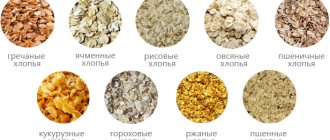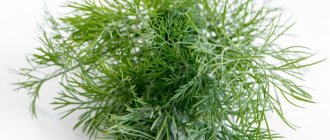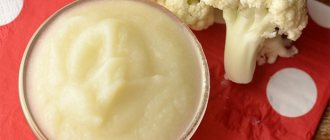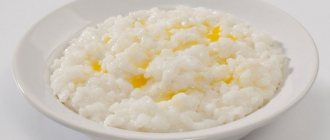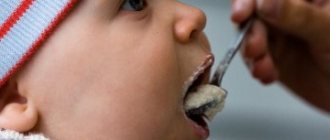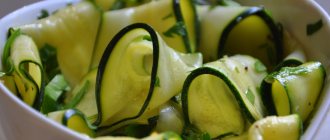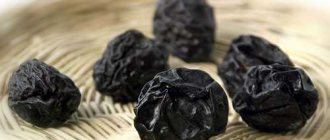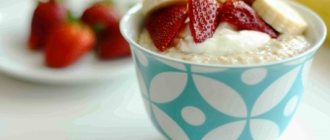By six months, the baby becomes more independent, actively interested in surrounding objects and spends much more energy on movements. From this moment on, the child’s body needs additional energy, the supply of which can be provided with cereals for the first feeding.
Dairy-free corn porridge for a 1-year-old child is a great way to satiate your baby and fill his body with essential microelements and vitamins.
Composition of cereals and its properties
Corn grits, like the cereal itself, will be useful to the baby due to its composition:
- A rich vitamin and mineral complex is necessary for the development of all systems and organs, as well as for their vital functions. Among the vitamins, corn contains A, E, PP, group B, K and C. It also contains minerals - phosphorus, magnesium, silicon, potassium, iron, calcium.
- Fiber is necessary to normalize the functioning of the gastrointestinal tract, eliminate constipation, etc.
- The same composition helps strengthen the immune system, naturally improve the intestinal microflora, reduce increased activity and hyperexcitability, and relieve pain in the oral cavity during teething.
- Thanks to its composition, corn is able to strengthen blood vessels and cleanse them for the normal functioning of the heart and the entire vascular system.
- This is one of the least calorie porridges, so it usually does not cause tummy problems.
Corn porridge for children: benefits and harms
After rice and buckwheat porridges, you can introduce corn porridge into your baby's complementary foods. By this time he should already be 9 months old. It is priceless because it does not contain gluten, which means it is completely safe for allergy sufferers. So, what is its benefit for a small organism that is growing and getting stronger day by day?
Properly cooked corn porridge is of great value for children's health because:
- incredibly useful for digestion, because the fiber in its composition stimulates normal intestinal function;
- makes life easier for those babies who suffer from constipation;
- able to inhibit putrefactive processes and fermentation in the intestines;
- calms the child’s seething and “talking” belly;
- strengthens the immune system;
- removes excess fat from the body;
- normalizes the functioning of blood vessels and the heart;
- The silicon in its composition helps solve dental problems.
This is only part of the benefits of corn porridge for children. It also delivers a lot of vitamins and minerals to the small body, which are actively involved in the functioning of all systems and organs. Therefore, you should not hesitate and deprive your child of such a healthy pleasure.
How to cook corn porridge for a child so that it is as healthy as possible? To do this, it is better to follow certain instructions, because experiments can lead to undesirable consequences.
- Rinse the cereal with cold water (one or two times is enough).
- Dry.
- Grind it in a coffee grinder or grind it with a blender (this is necessary if the child is less than a year old: for older children this is no longer necessary).
- For cooking, use dishes with a non-stick coating, otherwise you risk ruining the taste of the child's dish, and the child will refuse to eat it once and for all.
- The crushed cereal is poured with hot water (or milk), brought to a boil and cooked with constant stirring for about 15–20 minutes over low heat.
- If desired, you can express a little breast milk into it before feeding.
- Sugar can only be used after a year. Before this, for sweetening, it is better to add a banana or apple in the form of puree.
- For taste, you can add a little butter to the dish.
- The frequency of complementary feeding is once a week.
The rules are simple and will not require any special troubles from the young mother. Corn porridge for children can be prepared not only in a regular saucepan, but also in a slow cooker, a double boiler, and even in the oven. Now all that remains is to find out the recipes and please your baby with a new dish.
Choose corn porridge recipes for children depending on the cooking technology, ingredients and age of your child. It is advisable not to change anything in dosages.
Store-bought porridge for infants does not require cooking or additives. Dilute the required amount with chilled boiled water, you can add breast milk - and the miracle porridge is ready! These are one of the first cereals that are introduced into a baby’s diet.
Pour boiling water (200 ml) over corn grits (200 g), put on low heat, after 15 minutes pour in hot milk (100 ml), cook for another 5 minutes. Add salt (2 g) and butter (3 g).
Pour crushed corn grits (glass) with hot milk (glass), boil, season with salt (2 g) and butter (3 g).
Now you know how healthy and important corn porridge is in the diet of children. Be sure to learn how to cook it and delight your baby with a tasty and healthy dish regularly.
Nutritionists recommend that healthy corn porridge be consumed by both children and adults, the elderly and weakened after illness. Mothers are interested in the benefits of corn porridge for the child’s body, at what age is it better to include it in the children’s menu, and how to properly prepare dishes for children from it.
The birthplace of corn is Central America, where the crop was grown 7 thousand years BC. e. The cereal was brought to Europe by Columbus, and it was first called “Indian wheat.”
Different types of corn differ in stem height, ripening time, size, shape and color of grains, chemical composition, and taste. The color of the grains can be white, red, yellow, variegated.
The nutritional value of corn grits is determined by its composition.
100 g of cereal contains:
- carbohydrates 71 g;
- proteins 8.3 g;
- fat 1.2 g;
- dietary fiber 4.8 g;
- water 14 g;
- ash 0.7 g.
Carbohydrates are represented almost entirely by starch and dextrins (69.6 g), and sugars are only 1.2 g. Fat includes saturated and unsaturated fatty acids.
Corn grits proteins:
- 10 essential amino acids (including arginine, valine, isoleucine, lysine, phenylalanine);
- 8 essential amino acids (alanine, glycine, aspartic acid, tyrosine, glutamic acid, cysteine, serine, proline).
The energy value of 100 g of corn grits is 328 kcal. In 1 tsp. ready-made porridge contains 39 kcal, 1 tbsp. l. – 98 kcal, in a 200-gram serving of milk porridge – 1443 kcal.
The vitamin composition of the cereal is very rich: A, E, PP, niacin, biotin (vitamin H), beta-carotene, vitamins c. B (B1, B2, B5, B6, B9).
Corn grits contain minerals:
- macroelements – sodium, potassium, sulfur, phosphorus, magnesium, calcium;
- trace elements: copper, tin, iron, zinc, cobalt, chromium, manganese, molybdenum, aluminum, titanium, boron, nickel.
It is important that corn grits do not contain gluten (natural proteins that are part of many grains and contribute to the development of allergies). This makes corn a product safe for allergy sufferers.
Benefit
The rich composition of corn grits determines its beneficial effect on the child’s body.
Corn porridge is not only filling and tasty, but also healthy.
The impact of cereal nutrients is multifaceted:
- Pyridoxine (vitamin B6) takes part in the metabolic processes of proteins and fats, ensuring the functions of the central nervous system, maintaining the body's immune defense, promotes the formation of red blood cells, and normal heart function.
- Eating corn porridge promotes the normal development of the nervous system, prevents the development of neurological diseases, helps cope with depression, and improves sleep.
- Vitamin H is necessary for the synthesis of fats and the conversion of glucose into glycogen.
- Phosphorus is involved in metabolic processes and ensuring acid-base balance in the body. It is necessary for the synthesis of brain phospholipids and nucleic acids, ensuring the mineralization of bone tissue and tooth enamel. With a lack of phosphorus in the body, the child develops rickets and anemia.
- Vitamin B2 (riboflavin), biotin, zinc ensure healthy skin and nails, and hair growth.
- The antioxidant properties of vitamins E and A help tissue cells get rid of radionuclides and toxic substances.
- The product's fiber normalizes intestinal function and cleanses it of toxins. Eating corn porridge reduces the likelihood of fermentation and putrefactive processes. This reduces the likelihood of flatulence (bloating) and painful colic in babies, and makes bowel movements easier.
- Potassium, magnesium, pyridoxine ensure normal functioning of the cardiovascular system and correct heartbeat rhythm.
- Activation of metabolic processes, normalization of fat metabolism, and the cleansing functions of porridge lead to the removal of excess fat, prevent the development of obesity, and normalize cholesterol levels.
- Corn porridge is an excellent source of energy, has a general strengthening and immunostimulating effect, and helps recovery after illness.
- The quickly arising feeling of satiety when eating porridge prevents overeating, which is important for children with excess body weight.
The valuable properties of corn porridge make it possible to use it in the diet of children of all ages, including infants. The rich composition and easy digestibility of porridge make it possible not only to diversify a child’s menu, but also to improve his health.
Possible harm
Although corn porridge requires a relatively long time (45-50 minutes) to prepare, it is easily absorbed in the child’s body.
There are no carcinogens or other harmful substances in it. Therefore, corn porridge can have a negative effect on the body only if it is consumed in excess - too often or in excess of the age norm of consumption.
- Overeating can cause in a child a violation of the acidity of gastric contents, indigestion, and a feeling of discomfort.
- A large amount of phosphorus in cereals, if the baby is fed corn porridge too often, can lead to the leaching of calcium from bone tissue, which will have a negative impact on the formation of the skeleton.
Experts recommend introducing corn grits porridge at the age of 8-9 months, when buckwheat and rice have already become familiar to the baby.
First, you should prepare porridge not from whole grains, but from corn flour. It is easy to prepare it yourself using a coffee grinder. This kind of porridge takes less time to cook - about half an hour.
For an infant under one year old, porridge should be prepared with water, without salt or sugar. You can add a little breast milk (or formula) to the finished porridge to get a familiar taste for your baby.
During the day, it is necessary to monitor the baby’s body’s reaction to new complementary foods. If there are no negative manifestations, the next day the portion of porridge is doubled.
Gradually the portion is brought to the age norm:
- 150 g at 9 months;
- 200 g per year.
Corn porridge should be on the menu no more than 1-2 times a week.
If after the first tests the baby develops negative symptoms (rash, abnormal stool, abdominal pain), then corn porridge is excluded from the diet for 1-2 years, repeated tests are agreed with the pediatrician.
Cereals should be thoroughly washed before cooking. To make the porridge lighter and cook faster, you can pre-soak it in cold water for 30 minutes. Cooked with milk, the porridge will be soft and crumbly.
You can cook porridge with milk (if the child can tolerate it) after 10-12 months. After a year, you can add a little butter or vegetable oil to the porridge. Adding a small amount of salt and sugar is only permissible for children after one year.
During infancy, corn porridge can be prepared:
- with vegetables;
- meat puree;
- fish (if tolerated).
When to introduce corn porridge
Despite the fact that this product does not contain gluten, doctors do not recommend giving corn porridge until 8-9 months. As a rule, the introduction of such dishes begins with buckwheat and rice, gradually preparing the baby’s intestines for new treats.
Pediatricians do not advise starting complementary feeding with porridge for infants in principle, since it is believed that they contribute to active weight gain. However, everything is individual: if the baby is really small for his age, a high-calorie dish will be the best option for starting complementary feeding. Another reason for introducing cereal dishes is a negative reaction of the baby’s intestines to vegetables.
Oatmeal for babies with constipation
Oatmeal for babies (children's)
Many mothers wonder what complementary foods to give to their infants first. Pediatricians answer this question in different ways. Some say with juices, others with vegetables, and still others suggest starting complementary feeding with cereals. At what age should porridge be introduced to infants? It turns out not earlier than 5 months. You need to look at the child’s stool and, focusing on it, choose the food you need. Oatmeal for babies is useful in one case, but not in another. If constipation in a baby is a rare occurrence, he doesn’t eat much because he gets full quickly, and he doesn’t have any food allergies, then you can introduce this baby dish into the diet. Oatmeal is very healthy for a child, because it contains many different vitamins and minerals that are necessary for babies at this age. The only drawback is the presence of gluten. This is a protein that can affect digestion and cause allergies. If your baby has digestive problems and is constantly worried about bloating, then it is better to refrain from oatmeal and try serving something else.
Special children's oatmeal has a base of oatmeal. This product is a fine powder that resembles flour. Many mothers think that if porridge for children looks like this, then it is light, the baby will quickly digest it, and he will not suffer from bloating. But this is not entirely true, because baby oatmeal for infants, which has this consistency, still contains gluten. So do not give it to your child if your baby has frequent bloating. This type of food should also be given no earlier than 5 months and also be guided by the toddler’s stool.
Levomycetin is possible for a newborn. Often, for infectious inflammation of the eyes, adults and children are prescribed Levomycetin eye drops. These are justified measures, since they are an antibiotic that is effective against many bacteria. Let's consider what else
Baby food such as oatmeal is easy to prepare and contains not only gluten, which is so insidious, but also a large group of vitamins: iron,
Source
Corn porridge for children (4 recommendations 5 top recipes)
Children develop very quickly, and in order to support their development, help the body, strengthen it with vitamins, it is important to create the right diet for the baby. Today we will talk about corn porridge, how healthy it is, and at what age can a child be introduced to this product.
The variety of food that can be prepared from corn is sometimes surprising, no matter what they make from it: soups, salads, cereals, sticks, just boiled cobs. A universal product, don't you agree?
An interesting fact is that until the 18th century, corn was grown only for decorative purposes.
Corn porridge is a dish that is prepared not from the grains themselves, but from the cereal. Corn porridges are very attractive to children with their unusual and bright color. This sunny porridge will also delight your baby with its taste.
Composition of cereals
Corn grits are an acceptable product for baby food; they can impress with their supply of vitamins and microelements that stimulate the functioning of all organs. It contains most of the representatives of the vitamin B complex (folic acid, thiamine, B6). 100 grams of this cereal contains ¼ of the daily value of vitamins A and E.
The list continues:
- potassium;
- sodium;
- boron;
- iron;
- copper;
- calcium.
Corn grits are rich in fiber and starch.
200 grams per week is a sufficient dose for children, do not get carried away with one product. The menu for a child should be varied, which will have a positive effect on his well-being.
Properly prepared porridge is valuable for children's health.
- It is good for digestion (fiber stimulates proper intestinal function);
- Strengthens teeth (silicon);
- Nutritious and does not cause allergic reactions;
- Inhibits the fermentation process in the stomach (good for children who suffer from constipation).
The first thing you need is to attract the baby with the appearance of the dish. The second is the taste, so that he likes the porridge and would always eat it with pleasure. Here are some cooking tips.
- Prepare porridge only from fresh cereals, so you will get the maximum benefit.
- Cook the porridge in a container with a thick or non-stick coating, this way you reduce the risk of spoiling the taste.
- Corn porridge can be either a sweet or savory dish.
- Corn porridge is usually introduced into the menu from the age of 9 months, after you have already introduced him to buckwheat and rice.
Coarse grains last longer; before preparing them for the children's menu, they can be ground again using a coffee grinder or food processor.
Ingredients
- 5 cups of cereal;
- 5 cups of water.
Cooking method
Pour the washed cereal into boiling water, stirring constantly, cook the porridge over low heat for 7 minutes. Then put in an oven preheated to 150 degrees for half an hour. Allow the finished porridge to cool slightly and blend it with a blender. You can add a little breast milk, for older children a teaspoon of butter per serving, a grated banana or apple.
It would seem - what kind of wisdom is there? Pour in the cereal and let it cook. But there are still nuances...
- Be sure to rinse the corn grits before cooking.
- Place the cereal in a thick-bottomed pan, first filling it with water. Simmer under the lid until completely boiled, and then add milk.
- Cook corn porridge in milk for 15 minutes.
Ingredients
- 400 ml water;
- 200 ml milk;
- 150 grams of cereal;
- a pinch of salt.
Preparation
Pour water into a thick-bottomed pan and add clean cereal. After boiling, reduce the heat to low, add salt and cook the porridge until that moment, do not forget to stir so that the porridge does not burn. As soon as the water has completely boiled away, pour in the milk and wait another 5 minutes.
The porridge is ready!
Cooking corn porridge in a slow cooker is even easier than in a saucepan, which makes mommies very happy. You can put food in the kitchen aid and feel free to go for a walk with your child - lunch will be ready when you return.
Subtleties of cooking porridge in a slow cooker:
- For children, it is better to choose finely ground cereal. It will cook faster, and the porridge will have a delicate texture.
- In a slow cooker, the porridge will become much larger in volume, so the proportion of liquid and cereal needs to be increased.
- If you want to make the porridge thicker, leave it in the “warm” mode for 15 minutes.
Products
- 50 grams of cereal;
- 200 ml milk;
- 100 ml water;
- 1 tsp butter;
- 5 tbsp. sugar or honey.
Preparation
Place washed corn grits, butter and sugar into the multicooker container. Mix with milk and water. Set the “milk porridge” mode for 35 minutes. The resulting porridge will be liquid, and the corn particles will become soft and delicate in taste.
Products
- 200 grams of cereal;
- 500 ml milk;
- 400 grams of pumpkin;
- 50 grams of butter.
Preparation
Pour boiling water over the washed cereal and leave it for 40 minutes to swell. Cut the pumpkin into cubes and simmer in a frying pan with sugar. Drain the water from the cereal, boil the milk and add corn grits to it, stirring constantly.
https://www.youtube.com/watch?v=RflI7WYjutE
The porridge will cook over low heat for about 15 minutes. 3 minutes before readiness, combine the pumpkin with the porridge and mix thoroughly with the oil.
Ingredients
- 400 ml milk;
- 400 ml water;
- 200 grams of corn grits;
- 2 ripe bananas;
- 50 grams of butter;
- salt, sugar to taste.
Fill the cereal with water and put it on fire. When it boils, add salt and sugar, reduce the heat to low. While stirring, wait until all the water has evaporated.
Then we grind the porridge with a blender and fill it with hot milk, add butter and let the porridge boil.
Puree the banana and add it to the porridge, stir.
conclusions
Properly prepared corn porridge has every chance of becoming your baby's favorite dish.
This is a delicious breakfast, a healthy lunch, and a hearty but not heavy dinner. This porridge can be introduced next to buckwheat and rice cereals, after your child is 9 months old. Its advantage is that it does not contain gluten, so it is well suited for children with allergies.
Recipes
Before cooking cereals, it is necessary to take into account that only a one-year-old child can chew food effectively, so it is important to give homogenized foods to children under 12 months of age. Pediatricians and gastroenterologists insist that it is better to give preference to cereals and grind them yourself.
Cereals made from corn cobs do not lose their beneficial characteristics when exposed to high temperatures.
When choosing a product, it is recommended to adhere to the following principles:
- color of the cereal - we give preference to bright yellow cereal;
- grinding - it is better to give preference to rough, hollow;
- choose a product with a low content of dark grains;
- We pay special attention to the integrity of packaging and expiration dates.
Like all porridges, corn grits also tend to swell. It should be cooked in a ratio of 1:4, 1:3 with liquid. It all depends on the mother’s desire regarding the thickness of the future dish. Pour the thoroughly washed cereal into a container with boiling water. The optimal cooking time is 20–30 minutes. Then the porridge must be removed from the stove, covered with a towel and allowed to stand for about half an hour.
How to cook porridge
To learn how to cook porridge for babies, you should first choose what to cook from. You can choose an adapted mixture from the baby food category, or you can take corn flour. For older children, they also buy flakes made from this cereal.
When planning to introduce such porridge into your baby’s diet, keep in mind these simple rules:
- To cook porridge from flour, take a glass of liquid (water or milk, or a mixture of both) and 4 tbsp. l corn product. Bring the water to a boil, add flour and mix well. Continue stirring for 3 minutes, after which the dish is removed from the heat and left for about another half hour.
- If you took the cereal not from baby food, then it should be ground to the state of flour - only in this form can corn be used in preparing dishes for a newborn. Only then will the porridge be light enough. It will not cause discomfort and will be well received by the baby.
- If you use a slow cooker, use cereal and water in a ratio of 1:3. These porridges for babies are cooked in the “rice” mode. Then the dish will turn out crumbly and aromatic.
- For older toddlers, you can also take milk. It is advisable to buy store-bought - processed in such a way as to eliminate the risk of infection by pathogenic bacteria.
- For babies, you can add breast milk to the finished porridge, especially if you do not add sugar or salt to the dish.
- Butter, salt and sugar begin to be added to treats from about a year old, if the baby accepts these additives normally. You can also make the porridge even tastier with the help of dried apricots or raisins, if, of course, the baby loves dried fruits.
- Infants up to one year old can be offered a treat with vegetables or in vegetable broth, boiled with the fruits that you have already introduced into the baby’s diet.
Tip 1: How to cook porridge for babies
Before the first complementary feeding, parents have practically no problems with the baby’s nutrition.
But after about six months, difficulties may arise. One of the pressing issues is porridge for babies. If you prepare this dish incorrectly, your baby will have tummy problems. Pediatricians recommend starting complementary feeding with gluten-free cereals - buckwheat, rice and corn. These cereals do not cause allergies and also help improve digestion. However, you need to know that it is not advisable to give rice to children who are constipated. Buckwheat porridge, on the contrary, is given for bloating and problems with stool.
After a year, you can gradually introduce semolina and oatmeal into the children's menu. Until this age, the child’s stomach is not able to cope with these porridges. And semolina can generally cause necrosis of the intestinal villi, as a result of which the absorption of nutrients is reduced.
You should not give your baby instant porridge. They are made from processed raw materials, so they lose the lion's share of their benefits. It is worth purchasing the most ordinary cereal without additives and preparing porridge from it.
Porridge for babies is prepared with water, vegetable broth, breast milk or special baby milk. It is undesirable to use cow's and goat's milk, which is poorly digested by the delicate stomach of a six-month-old child. Such fatty dairy products can be introduced into a baby’s diet only from 9-12 months, and then only by diluting them with water in a 1:1 ratio. In addition, it is not recommended to add salt, sugar or honey to the finished porridge. Let the child first get used to the original taste of the dish.
Wash the cereal thoroughly. You can generally soak rice in cold water for several hours. Drain the water, dry the cereal a little, and then grind it in a coffee grinder or blender. You need to grind not into flour, but until small grains form.
Any baby porridge is prepared strictly according to the recipe. On
Source
About the product
The uniqueness of corn porridge lies in the fact that it can be made with almost anything - milk, plain water, meat or vegetable broth. In any culinary version, the product will be directly related to a healthy and balanced diet, since no heat treatment destroys the beneficial substances contained in such porridge.
Cereals are produced by crushing dried corn grains. Depending on how finely and thoroughly the grain is crushed, the grinding class depends. There are five types of maize groats. The fifth is the coarsest, the first is extremely delicate; for example, it is used to make not only delicate and tender porridge for toddlers, but also corn sticks, beloved by children.
The Aztecs began to use corn separately and in cereals; mentions of this are preserved in historical sources. It is known for certain that it was fatty corn porridge that the hospitable Indians greeted the conquistadors even before hospitality “backfired on them.” Columbus brought not only tobacco to Europe, but also corn seeds. In Russia, since the 17th century, it was grown in the Caucasus and southern regions, and its widespread distribution became possible thanks to Nikita Khrushchev’s special love for culture.
Corn porridge is known in all cuisines of the world. Georgians call it gomi, Italians call it polenta. Moldovans and Ukrainians call the product mamaliga.
How is it useful?
For a child, corn porridge is a rich source of energy, which children require much more than adults. But the advantages of maize porridge do not end there. Firstly, it contains the least amount of gluten compared to other cereals - rice, wheat, oats.
Secondly, corn grits are rich in B vitamins and contain vitamins A and E. A large amount of fiber in such a dish will help cope with constipation. Corn “sludge” in water is excellent for weakening after many days of difficulties with bowel movements. Even a large amount of porridge does not strengthen at all.
The product is very rich:
- zinc;
- manganese;
- selenium;
- iron;
- copper;
- calcium;
- potassium;
- gray;
- magnesium;
- sodium;
- phosphorus.
Porridge is quickly absorbed by the human body, gently digested, and eliminates toxins and waste. If you give this porridge regularly to a child from an allowed age, you will notice that it strengthens the immune system, nails, hair become stronger and more beautiful, teeth and bone tissue become stronger.
Corn porridge is considered an excellent food for the prevention of tumors and neoplasms, as well as for the treatment of anemia, since the mineral composition of the cereal helps to increase the level of hemoglobin in the blood. Porridge is good for hyperactive children because it is rich in magnesium, which is an excellent sedative.
The combination of calcium and silicon makes corn porridge very useful for children's teeth, especially during the period of their intensive growth, and then when milk teeth are replaced by permanent ones. If a child eats maize porridge regularly, he will not gain weight, as happens with semolina. The balanced composition and rapid digestion of the corn product helps maintain weight and reduce it, even with an impressive stated calorie content.
Age restrictions
Despite all the benefits of the product, nutritionists and pediatricians do not recommend introducing corn porridge in the form of crushed cereal for infants. Enzymes that would help such porridge to be digested faster with maximum benefit for the child’s body are not produced in sufficient quantities at an early age, and maize porridge will be somewhat heavy for him.
The exception is special children's dietary corn porridge, which is actually sold ready-made and labeled “for baby food.” It comes in dairy-free and dairy-free varieties. Dairy-free food is more suitable for complementary feeding, since it is less likely to cause allergies, in particular to milk protein.
It is recommended for a child to buy cereal in a store and cook porridge from it no earlier than 8 months. For an eight-month-old baby, porridge is introduced gradually, starting with small portions. You should carefully monitor your reaction to this product. If redness of the skin, itching, signs of indigestion, diarrhea or constipation, bloating, belching appear, then it is better to postpone the idea of feeding this porridge to an 8-month-old baby until a later age.
Children with allergies who are prone to food and other types of allergies should not be given corn porridge until they are 1 year old. After this age, you can give the product in small portions. First in its pure form, then, in the absence of a negative reaction from the body, you can give maize porridge with fruits and berries.
The allergenic component of corn grits is quite arbitrary. It is believed that the body's immune response can be provoked by natural substances that color the cereal in a beautiful yellow-golden color. It should be noted that allergies to this natural dye rarely occur in children.
Nevertheless, it is believed that it will be better if the child begins to eat such a product after his digestion has adapted to some other cereals, and therefore corn porridge should not be considered for the first complementary feeding.
Corn flour porridge for babies
Your baby has grown up. The time has come for complementary feeding, as the baby needs an additional source of energy. You have already tried buckwheat and rice porridge, now is the time to introduce something new into your diet, but equally healthy and tasty. Corn porridge for babies belongs to this product.
Rules and terms for introducing corn porridge into the infant's menu
There are generally accepted rules for starting complementary feeding, developed by health organizations, but for each baby everything is individual. The age recommended by pediatricians for introducing corn porridge is 7-8 months, but provided that the newborn has already mastered some vegetables, rice and buckwheat. There are exceptions. If the newborn’s stomach does not accept other cereals or the baby is not gaining weight well, then the pediatrician may allow you to start consuming liquid corn porridge when breastfeeding at six months, and when bottle-fed at five months.
When trying to introduce a new dish, a nursing mother should not forget about the beneficial benefits of breastfeeding: the baby should not be abruptly weaned from the breast and transferred to “adult” food; complementary foods should replace the breast gradually.
First, give newborn children 1⁄2-1 teaspoon of porridge to try and observe for a couple of days how the baby’s body reacts to the innovation in his diet. If everything is fine, we continue to feed the baby.
If there is a change in stool (constipation or weakness), an allergy to corn porridge (for example, redness of the skin, rash, itching), the child becomes restless and capricious, the tummy is swollen, then the new dish should be temporarily excluded. You can give it to your child again no earlier than after 5-6 months.
When should you not give?
The glycemic index of this tasty and healthy dish is quite high. This should be taken into account by mothers of babies with congenital and acquired diabetes mellitus. The diet plan for such children does not include corn on the menu at all, neither in the form of grains nor in the form of cobs. Such a product will only cause harm.
If a child has an individual intolerance to corn and products made from it, such porridge should also be abandoned in favor of another, which will be approved by the pediatrician and allergist.
Some diseases of the gastrointestinal tract do not imply the presence of maize porridge on the menu. First of all, we are talking about peptic ulcer disease, inflammation of the pancreas. In this case, the corn dish can be taken only after the exacerbation of the disease has resolved with the permission of the attending physician.
Rice porridge for infants' first feeding
One of the important questions for a mother is what to give her baby as the first complementary food. Maintaining consistency when introducing foods into a baby’s diet is an important and responsible task. Rice porridge for babies is unanimously recognized as one of the best porridges for first complementary feeding.
The benefits and harms of rice porridge for infants
Rice occupies a leading position among complementary foods for infants for a reason. It has a number of useful and important qualities for a developing organism:
It contains 8 amino acids. One of their tasks is the “construction” of the body. By six months, mother’s milk does not contain enough microelements to meet the baby’s needs, so it is necessary to supplement the gaps.
Rice porridge is indicated for infants precisely because its starch-mucosal components protect the intestines and do not require the active work of enzymes for digestion and assimilation. But in infants, the enzyme base is in the “development” stage. It is not perfect at all, some elements are missing at all, others are in excess, therefore the work of the intestines is not stable and it is easy to “upset”.
The rice is strengthening. Any easily digestible product strengthens. If a child has problems with stool, with a tendency toward constipation, rice is highly undesirable.
Foreign manufacturers process rice grains to kill parasites and give them a marketable appearance. Any chemistry is contraindicated for infants. Choose your manufacturer carefully, focusing on local companies.
In connection with the above, it is necessary to limit the number of times you eat rice per week to avoid constipation and prevent a lack of calcium and iron in the body.
Could it be an allergy?
Allergies have many varieties and pathogens. A rather rare form is intolerance to the fiber contained in rice. ABOUT
Source
